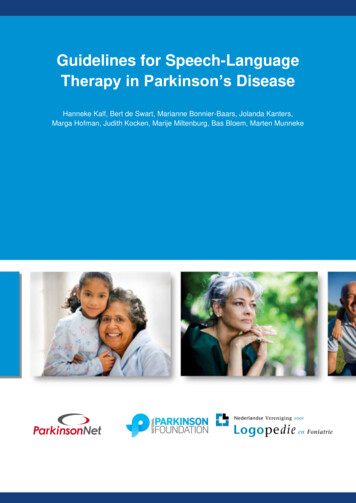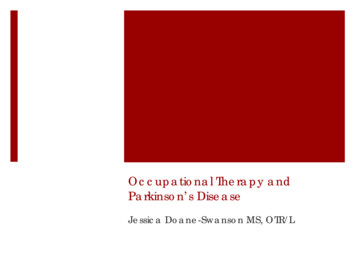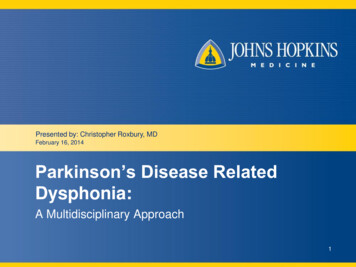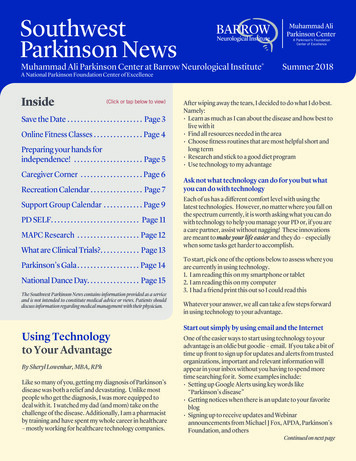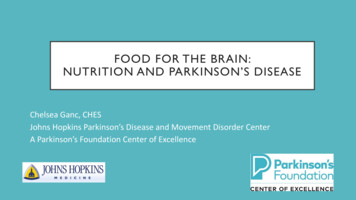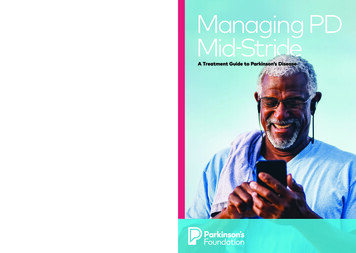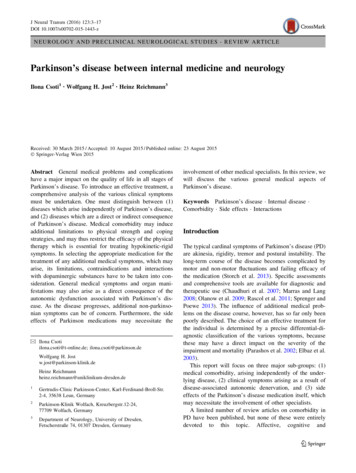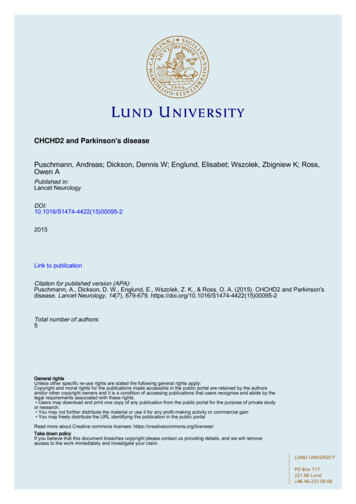
Transcription
CHCHD2 and Parkinson's diseasePuschmann, Andreas; Dickson, Dennis W; Englund, Elisabet; Wszolek, Zbigniew K; Ross,Owen APublished in:Lancet NeurologyDOI:10.1016/S1474-4422(15)00095-22015Link to publicationCitation for published version (APA):Puschmann, A., Dickson, D. W., Englund, E., Wszolek, Z. K., & Ross, O. A. (2015). CHCHD2 and Parkinson'sdisease. Lancet Neurology, 14(7), 679-679. https://doi.org/10.1016/S1474-4422(15)00095-2Total number of authors:5General rightsUnless other specific re-use rights are stated the following general rights apply:Copyright and moral rights for the publications made accessible in the public portal are retained by the authorsand/or other copyright owners and it is a condition of accessing publications that users recognise and abide by thelegal requirements associated with these rights. Users may download and print one copy of any publication from the public portal for the purpose of private studyor research. You may not further distribute the material or use it for any profit-making activity or commercial gain You may freely distribute the URL identifying the publication in the public portalRead more about Creative commons licenses: https://creativecommons.org/licenses/Take down policyIf you believe that this document breaches copyright please contact us providing details, and we will removeaccess to the work immediately and investigate your claim.LUNDUNIVERSITYPO Box11722100Lund 46462220000
CHCHD2 and Parkinson’s diseaseLancet Neurol. 2015 Jul;14(7):679. doi: 10.1016/S1474-4422(15)00095-2.Journal homepage: http://www.thelancet.com/neurologyLink to publication: IIS14744422(15)00095-2/abstractAuthors:Andreas Puschmann, MD (corresponding author)Lund University, Department of Clinical Sciences, Lund, Neurology,and Department for Neurology, Skåne University HospitalGetingevägen 422185 Lund, SwedenPhone: 0046-46-171000Email: Andreas.Puschmann@med.lu.seDennis W. Dickson, MDDepartment of Neuroscience (Neuropathology)Mayo Clinic Jacksonville4500 San Pablo RoadJacksonville, FL 32224, USAEmail: Dickson.Dennis@mayo.eduElisabet Englund, MDLund University, Department of Clinical Sciences, Lund, Oncology and Pathology, Sweden,and Department of Clinical Pathology, Skåne University Hospital, SwedenSölvegatan 2422185 Lund, SwedenEmail: Elisabet.Englund@med.lu.seZbigniew K. Wszolek, MDDepartment of NeurologyMayo Clinic Jacksonville4500 San Pablo RoadJacksonville, FL 32224, USAEmail: Wszolek.Zbigniew@mayo.eduOwen A. Ross, PhDDepartment of NeuroscienceMayo Clinic Jacksonville4500 San Pablo RoadJacksonville, FL 32224, USAEmail: Ross.Owen@mayo.edu1
Funayama and colleagues recently identified a mutation in the CHCHD2 gene in a largeJapanese family with autosomal dominant Parkinson's disease, 1 increasing our knowledgeon the monogenic causes of this disorder.2, 3 They also found the same mutation (182C T,Thr61Ile) in another family with autosomal dominant Parkinson’s disease; the mutation wasdetected not only in a man with familial disease but also in his brother, who had developedfine tremor at age 10, but had no Parkinsonism at 50 years of age.1On the basis of this finding, Funayama and colleagues suggested that a CHCHD2 mutationmight also be the genetic cause in the Arkansas family that we have followed longitudinallyand have described previously.4 The family is large, with affected individuals in sixgenerations who have clinical parkinsonism, essential tremor, restless legs syndrome, anddepression, alone or in various combinations. Signs of postural or action tremor werepresent in 25 family members, of whom six also had Parkinson's disease. Tremor startedinsidiously and in three cases during childhood, although it often remained mild.Neuropathological examination of two family members showed spheroid pigmentdegeneration with ubiquitin-positive axonal spheroids in the pallidum and substantia nigra,TAR DNA binding protein 43-positive pathology in the basal ganglia, hippocampus, andbrainstem, and only sparse Lewy bodies; both individuals had a combination of essentialtremor, parkinsonism, and depression.4We identified similar neuropathology in an affected individual from the Swedish family F081; members of this family had a similar clinical picture to the Arkansas family members.Six members in three generations had Parkinson's disease with an autosomal dominantpattern of inheritance;5 symptoms started between ages 55 and 63 years. Three patientswith Parkinson's disease had resting tremor, one had severe tremor and received deep brainstimulation, and one had restless legs syndrome for several years before the onset of2
parkinsonism. Three patients with parkinsonism had mild cognitive impairment, comparedwith only one patient in the Arkansas kindred. Neuropathology in one member with tremordominant parkinsonism and mild cognitive impairment showed diffuse Lewy body diseaseand arteriosclerotic vascular disease. Unusually, we found TAR DNA binding protein 43positive neuronal cytoplasmic and intranuclear inclusions and dystrophic neurites in thehippocampus, but not in the cortex or amygdala, and only sparse lesions in the basal gangliaand brainstem; we did not detect any Alzheimer's pathology.The entire coding sequence of the CHCHD2 gene was analysed in four individuals from theArkansas family, including two with Parkinson's disease and two with essential tremor, andin two first-degree cousins with Parkinson's disease from the Swedish family F-081. TheCHCHD2 Thr61Ile substitution was not identified and we did not detect any other mutationin the gene. Although not present in our families, we will be interested to see whether otherresearch on CHCHD2 mutations will add to the slowly emerging knowledge about thegenetics of essential tremor.Declaration of interests:The authors declare no competing interests.Disclosures:Dr. Puschmann reports grants from The Swedish Parkinson Foundation (Parkinsonfonden),grants from governmental funding for clinical research within the Swedish National HealthServices (ALF), grants from Bundy Academy, Sweden, grants from The Swedish ParkinsonAcademy, during the conduct of the study; personal fees from Lundbeck AB, Sweden,3
personal fees from Swedish National Board of Health and Welfare (Socialstyrelsen), outsidethe submitted work.Dr. Wszolek reports partial grant support from NIH/NINDS P50 NS072187, and reports a giftin the form of grant support from Carl Edward Bolch, Jr., and Susan Bass Bolch.Dr. Ross reports grants from NIH grants NS078086 and NS072187, grants from The Michael J.Fox Foundation, during the conduct of the study; and membership on the editorial boardsof American Journal of Neurodegenerative disease, Molecular Degeneration, andParkinsonism and Related Disorders and PLoS ONE.Role of the funding sources:The sources funding this study had no role in the writing of the manuscript or the decision tosubmit it for publication.Authors’ contributions:Andreas Puschmann: Literature search, data collection, data analysis, data interpretation,writing; Dennis W. Dickson: Data collection, data analysis, data interpretation, critical reviewof manuscript; Elisabet Englund: Data collection, data analysis, data interpretation, criticalreview of manuscript; Zbigniew K. Wszolek: Study design, data collection, data analysis, datainterpretation, critical review of manuscript; Owen A. Ross, PhD: Study design, datacollection, data analysis, data interpretation, critical review of manuscript.4
References:1. Funayama M, Ohe K, Amo T, et al. CHCHD2 mutations in autosomal dominant late-onsetParkinson's disease: a genome-wide linkage and sequencing study. Lancet Neurol 2015;14: 274–822. Singleton A. A new gene for Parkinson’s disease: should we care? Lancet Neurol 2015; 14:238–9.3. Puschmann A. Monogenic Parkinson's disease and parkinsonism: clinical phenotypes andfrequencies of known mutations. Parkinsonism Relat Disord 2013; 19: 407–15.4. Puschmann A, Pfeiffer RF, Stoessl AJ, et al. A family with Parkinsonism, essential tremor,restless legs syndrome, and depression. Neurology 2011; 76: 1623–30.5. Puschmann A, Lindskov S, Marktorp C, et al. Hereditary Parkinson’s Disease of UnknownGenetic Cause in Two Families from Southern Sweden. Mov Disord 2010; 25: ix.Copyright 2015 Elsevier Ltd. All rights reserved.5
and Department for Neurology, Skåne University Hospital Getingevägen 4 22185 Lund, Sweden Phone: 0046-46-171000 Email: Andreas.Puschmann@med.lu.se Dennis W. Dickson, MD Department of Neuroscience (Neuropathology) Mayo Clinic Jacksonville 4500 San Pablo Road Jacksonville, FL 32224, USA Email: Dickson.Dennis@mayo.edu Elisabet Englund, MD
